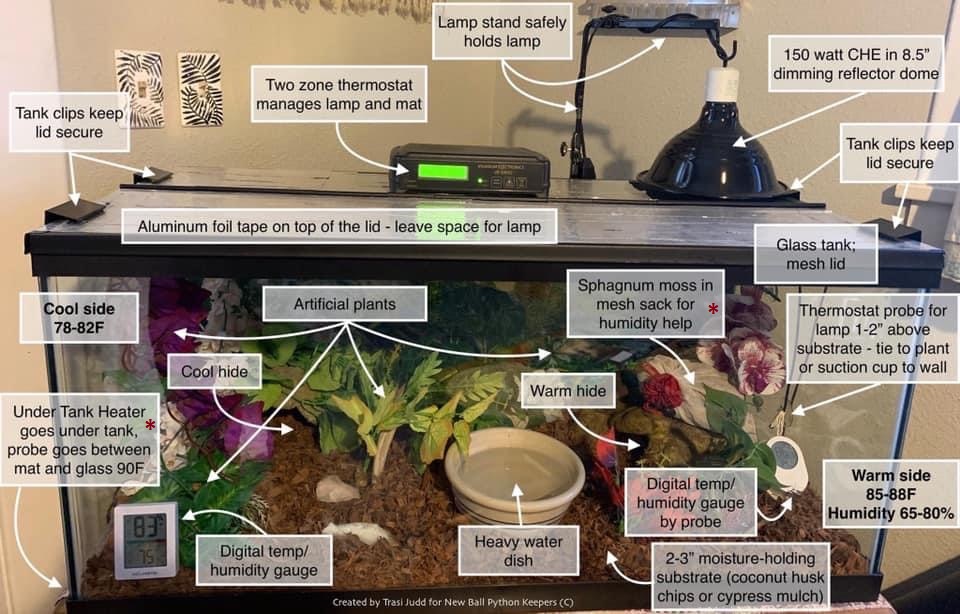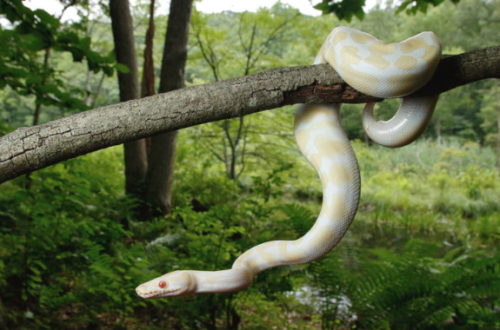Maintaining Humidity & Heat
Hello, my fellow reptile enthusiasts. Today I want to take a moment and discuss something that comes up quite frequently; how to maintain proper humidity levels and ambient temperatures for species with narrow requirements. I will focus on ball pythons but these methods will work well for other species with similar husbandry needs. Please visit the Ball Python Care & Feeding Guide page for more information on keeping these fantastic pet snakes.
A glass tank is the most common type of enclosure in the pet industry. While these “tanks” are not the best for Ball Pythons, it is one of the more affordable and readily available housing options. You can make your glass tank work, but it will take some modifications and extra effort to keep your snake happy and healthy.

The above is the illustration we have in our Glass Tank Setup Guide (PDF). There are a few things here that address both humidity and temperatures. Let’s go over them one at a time.
Aluminum foil tape on top of the lid. This is a very easy way to help trap both the humidity and heat inside your tank. It acts as a physical barrier. You only need to leave a square for your heat lamp dome to sit on or just above and any lighting you have on/over the lid. That is all the ventilation your snake will need. This tape is commonly known as HVAC Foil tape and can be purchased at any home improvement store, like Lowes. You can also order it on Amazon: https://amzn.to/3gbtigq. Just be sure it’s the kind with a paper backing, it is thin metal that’s sticky. It sticks better and is longer lasting than plastic tape which has a thinner reflective layer in it.
Heavy water dish on or near the hot side. Placing the water dish close to the heat source will increase evaporation as the water warms up. This, in turn, increases humidity levels. The larger the water dish, the more humidity it will create. Just be sure to clean it regularly as your snake will likely take a dip in it from time to time.
A thick layer of a moisture-holding substrate. This is imperative to get right. Many bedding options sold at pet stores are not going to be a good fit for maintaining high humidity. Aspen and similar light wood bedding absorb moisture, it dries quickly, and it will get moldy if kept wet, especially around the water bowl. Bark-type substrates don’t hold moisture at all and are often dyed which can transfer to your snake, though they tolerate humidity without much mold. It is best to use 2-3″ of a substrate that retains moisture and releases humidity slowly. The best we have tried is cypress mulch with chunky coconut husk a close second. Adding some undyed sphagnum moss mixed in will give the humidity an extra boost as well if you are still struggling to keep it high enough. The dirt-like fine coco coir substrate is NOT recommended for most snakes. It dries out quickly and when wet, it can stick on prey items, it will get stuck in heat pits, and it can get in their mouths when they eat. It’s just not ideal. It’s better suited to amphibians and invertebrates.
Now, the substrate will eventually dry out, sooner if you have low humidity in your home or have to use higher-wattage heat bulbs. The first thing to remember is, DO NOT mist the enclosure or your snake! Misting spikes humidity for just a short time. Humidity then drops quickly and these fluctuations can do more harm than good for your snake’s long-term health. Devices like foggers and misters are not a good idea either. They can build up mold and bacteria inside and they don’t create the kind of environment a ball python needs. They are designed to be used for rainforest species that need nearly 100% humidity. To rehydrate your substrate, pour a good bit of water directly into it. It’s up to you if you want to mix it in or just let it settle. It works fine either way. By adding water this way, you allow the bottom of the substrate to stay damp while the top layer dries back out. Substrate that is constantly damp will eventually cause scale rot, which is no fun to deal with for you or the snake. Most enclosures will maintain good humidity adding water once a week. More dry climates may need water added twice a week. Just watch your humidity gauge and add water as needed.
Ceramic Heat Emitter & Thermostat. First, a thermostat is not an optional piece of equipment. It is very important for maintaining the health and safety of your pet snake. A thermostat controls the heating elements you are using to keep temperatures steady and in a safe range for the animal. Heat mats fail, often. They can reach temps of 140 degrees or hotter very quickly. Snakes do not have the same kind of heat or pain receptors as we have in our skin. They will receive burns before they realize they need to move away from a defective or malfunctioning heat source. A budget on/off thermostat is better than nothing but a dimming/proportional thermostat with a safety shutoff and alarm is best. The one in the picture above is the VE-300-2x by Reptile Basics. It controls two zones, both an overhead heat source and a heat mat. Spyder Robotics has advanced Herpstat models as well. Inkbird makes a budge-friendly on/off thermostat that will also control two zones, but it does not have the safety features of the others. We have all of the linked brands of thermostats in use for our collection of animals and breeding operation.
Setting up a thermostat is easy to do. You plug the heat source into the thermostat and the thermostat plugs into the wall. There is a probe that measures the temperatures so the thermostat can turn on or off, or dim to match the settings you apply. For a heat mat, the probe should be placed between the heat mat and the bottom of the tank*. Your snake may burrow down to get closer to the heat, so you need to make sure it is safe for him to do so. The thermostat should be set to 90-92 degrees to keep it at a snake-safe range.
*NOTE: A heat mat or heat tape should always be placed on the outside of a tank or enclosure, never inside with the snake.
To control the overhead heat, your thermostat probe should be on the hot side hanging loosely a couple of inches above the substrate. Do not put it directly under the heat source. You want the ambient air temperature on your hot side to be ideal. It will be a few degrees hotter directly under the heat lamp. For ball pythons, I like to set the thermostat to 87 degrees. Use a secondary digital temp gauge at ground level to ensure the thermostat temp is correct and adjust as needed. An infrared temp gun is also handy to ensure the surface temp directly under the heat lamp is in a safe range (no hotter than 92-93 degrees).
There are two great heat bulb options for Ball Pythons: ceramic heat emitters (CHE) or deep heat projectors (DHP). A CHE is a metal heating element that is coated with ceramic, usually black or white. It doesn’t give off any light and should be left on 24/7 to maintain consistent temperatures (ball pythons do not need to have a night drop in temp). A DHP is a metal heating element encased in an aluminum housing. The heating coils will have a very faint red glow when it heats up, but it is not bright enough to disturb your snake or be noticeable at all. It looks like when an electric coil stove heats up. DHP provides more IRA wavelength heat and will get hotter than the same wattage CHE. We prefer to use CHEs though as they tolerate on/off thermostats better. The size/wattage you chose will depend on the size of the tank and the ambient temps in your room. A 20-gallon long glass tank will do well with a 75 or 100-watt CHE or 50-watt DHP. Larger enclosures or a room that dips below 65 degrees F (18 C) will require a 150-watt CHE or 100-watt DHP. It’s never a bad idea to go a size up on your bulb. The thermostat will keep your temps where you want them. Just be sure your dome has a ceramic base and it is rated for the wattage bulb you choose.
But, wait… Do I need overhead heat? Short answer, yes. Long answer, YEEESSSSS! A glass tank cannot maintain proper ambient temperatures for your ball python with just a heat mat and still maintain safe temps directly over the mat for your snake. Even with all of the modifications mentioned so far, your snake is likely to be too cool with a heat mat alone. You would need to heat the entire room to 80-82 degrees F (27 C) to keep your snake within proper temp ranges.
Insulating the tank! One thing not on this graphic is insulating your tank. Glass will hold in your humidity and keep drafts at bay, but heat travels through glass pretty easily. To help stop some of the heat transfer, you can add an insulating layer on the outside of the tank. We recommend using science fair-type foam core poster board on the back and sides. You can find it at an office supply store or Walmart in the school supply section. You could also go hardcore and pick up some foam insulation sheets from a home improvement store like Lowes. Clean the glass well with alcohol and use clear double-face tape to mount the board to your enclosure. Hot glue works as well. You can purchase or make a photo or artistic terrarium background to put on first if you want the inside of your tank to look more creative.
What if my snake still has a bad shed? A humid hide or humidity box can be a great solution for the problem shedder. When you notice your snake going into a shed cycle, feeling dry and the eyes getting a bit cloudy, add a humid hide or humidity box to the warm side of the enclosure. This is an additional hide to the ones you already have. A food storage container works well for smaller snakes. You will have to get more creative for larger ones. Or you can use a Black Box Hide and add damp moss under it, rewetting it every other day to keep it damp. Snake Discovery has a great video on YouTube showing how they make their humidity boxes. https://www.youtube.com/watch?v=kS8gZXXK7S4&t=282s



